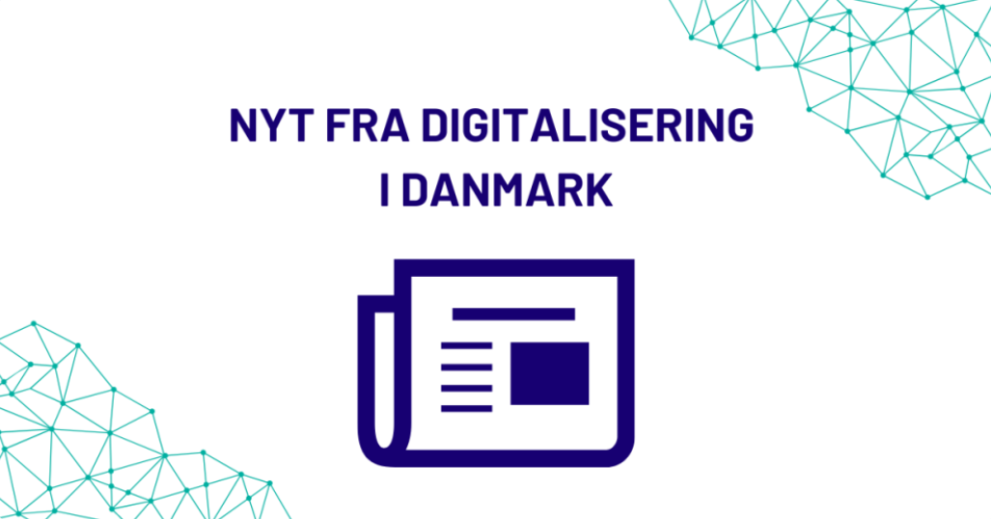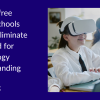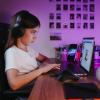Equip students with digital competences

Digital technologies is embedded in every aspect of our lives. Google presents us with search results that match what we've previously searched for. Politicians use Facebook's algorithms to influence voters. And few young people today can imagine life without their mobile phone as an extension of themselves. For many years, schools have used technology as a tool to support existing teaching. However, that way of looking at digital technology has changed. Today, technology and digital media play a much more integral role in our lives. There is therefore a greater need to equip young people to think critically and analytically about the technology behind it.
In the spring of 2019, the then Danish Minister of Education Merete Riisager (LA) launched a new course, ‘Technology Literacy'. As an experiment, 46 primary and lower secondary schools will implement technology literacy in their curriculum over a three-year period. Some of the schools will introduce technological literacy as an independent subject, while others will work with technological literacy as part of other subjects such as visual arts, Danish, physics/chemistry, crafts and design, mathematics, nature/technology and social studies.
Digital literacy should be more prominent
Even though none of the country's 240 secondary schools are participating in the project, it is necessary for secondary schools to also address technological literacy in their teaching, says Ole Sejer Iversen, professor and head of the Center for Computational Thinking and Design at Aarhus University. He has chaired the group that wrote the curriculum for the ‘technological literacy’ course and is one of the leading researchers in the field.
"All young people, including secondary school students, come across material on the internet with content that is inappropriate. We need to help young people build resilience so that they understand how to be critical of the things that come out of the screen," he says.
He expects all primary, secondary and upper secondary schools to take this task seriously and integrate technological literacy into their teaching. "I find it hard to imagine that they would stuff cotton wool in the ears of secondary schools," says Iversen.
Similar to Ole Sejer Iversen, John Klesner, chairman of the Danish IT supervisor association (which includes secondary school teachers), has been involved in writing the curriculum for the subject of technology understanding. Klesner emphasises that the main purpose of secondary schools obliges the schools to offer teaching and pedagogically organised socialising, where the main aim is democratic education. In the 21st century, you can't be democratically educated without being digitally educated, he points out.
"To be digitally literate is to be viable in a modern society," says John Klesner. Ole Sejer Iversen agrees, citing as an example how algorithms on Facebook and Google affect what we are exposed to. "Much of the democratic debate takes place through algorithms that are not neutral. To understand the democratic debate, you have to understand algorithms," says Iversen.
Teach students to understand the intention behind it
The vast majority of schools already use technology to support existing teaching - for example, with programmes like geogebra in maths and reading programmes. However, this is not technology literacy, the professor emphasises. According to Iversen, the idea of introducing a subject like technology literacy is to prepare children and young people for a digital world. One way to do this is by developing their analytical competences – similar to the way students learn literary analysis in Danish.
"We have a whole vocabulary to understand what messages literature has. As with Karen Blixen's short stories, all technologies come with an intentionality that is embedded in the technology. But unlike literary analysis concepts such as point of view shift and narrative model, we don't offer school students the same analytical framework for understanding digital technologies," says Ole Sejer Iversen.
The analytical part is also about what hides behind the often user-friendly interfaces of digital technologies. They often hide what processes are taking place. For example, many children and young people don't know what a file is.
"You need to know a little bit about what's under the bonnet of the computer. You may not need to know what's under the bonnet to drive a car, but the difference between using computer technology and a car is that in a car you still know where you're navigating to. You don't necessarily do that when using a computer," Ole Sejer Iversen points out. "There is a polarisation between those whose parents talk to them about digital technology and those who don't. We need to take massive action here, otherwise we'll end up with a society that breaks down," he adds.
The subject of technological understanding must also prepare students to be able to create new technologies themselves - and to create products with them. In other words, it is also a creative subject where students produce their own products. This can be done, for example, through teaching digital design, where students must consider the recipient and intention in the product.
"It provides a hands-on understanding that technologies are man-made and that some people create digital products with a specific intention. Students get an understanding that you can make demands on technologies and learn to understand the intentions behind them," explains Iversen. The same goes for programming. Not because, according to Ole Sejer Iversen, all students should be able to code professionally, but because programming requires students to take a phenomenon and translate it into computer language. They gain insight into the fact that digital systems are based on models of the world.
"Digital citizenship is one of the most important competences of the 21st century. Children and young people must learn both to construct with digital technology and to decode existing digital technologies," says Iversen.
Experts: Afterschool programmes need to start now
Don’t worry if this sounds like a lot, says Marie Falkesgaard Slot, Head of Research and PhD at UCL Business Academy and University College. As a researcher and academic leader in the trial, she has knowledge of the implementation of the subject of technological literacy at the primary schools participating in the trial. In addition, Slot has followed and analysed the teaching at secondary schools in 16 different subjects and 89 lessons. On this basis, she has contributed two chapters to the anthology 'Efterskolens praksis under lup. Studies of formative teaching and socialising', which was published in February.
Marie Falkesgaard Slot emphasises that the researchers' studies in connection with the anthology show that secondary schools are already taking on the task of teaching digital technologies in electives and core subjects where students work with IT and media. She sees a potential at secondary schools to include technological understanding in the teaching of compulsory subjects such as Danish and maths. But at the same time, she says that there is still some way to go before this happens: "In secondary schools, there is no strategic focus on how students work with digital learning materials and tools in compulsory education."
Marie Falkesgaard Slot encourages the individual secondary school to investigate which forms of digital teaching and IT didactics the school wants to support students' academic learning before deciding how technology understanding can become part of the teaching. She advises schools to take existing subjects as a starting point and examine how technology and understanding of technology is relevant to the subjects and traditions within the subjects.
"Once you've done that, there are plenty of opportunities to work with the new subject matter," says Marie Falkesgaard Slot. For example, a Danish teacher can take up a topic such as robot journalism and, together with the students, explore what it means that robots write articles.
If a school wants to introduce technological literacy as an independent subject, it will require a lot of supplementary training, says Marie Falkesgaard Slot. Ole Sejer Iversen agrees. However, he expects the state to allocate funds for continuing education if technological literacy becomes part of the compulsory subjects in primary and lower secondary school. However, there is no reason to wait that long. As a school, you can get started right away by letting teachers start with the subjects they already teach, emphasises Ole Sejer Iversen.
"The vast majority of teachers don't have the competences to teach technological literacy. But we don't have time to wait. Teachers can be inspired by the highly skilled teachers who are already working with the subject. Otherwise, it's about getting started and being curious about what new forms of realisation and expression technology provides within your subject," he says.
Ole Sejer Iversen believes that schools have an obligation to ensure that all young people learn digital literacy: "There is a polarisation between those whose parents talk to them about digital technology and those who do not. There needs to be a massive effort here, otherwise we will have a society that breaks down."
Behind the experimental programme with technological literacy
A three-year trial with technology literacy as a new subject in primary and lower secondary schools is underway across 46 primary schools. The schools will test whether the new subject can equip students to critically relate to technology and to shape it rather than just use it. In the trial, technological literacy as a subject is understood both as an independent subject and as part of other subjects such as visual arts, Danish, physics/chemistry, crafts and design, maths, nature/technology and social studies.
Technology literacy contains four competency areas:
- Digital empowerment: Students should be equipped to assess digital technologies. This means: What are the intentions of the product? How can it be utilised? And what consequences does it have for the individual, the community and society? On this basis, students will learn to come up with concrete proposals for re-design.
- Digital design and design processes: Students will design digital products so that other people can use them. This means that students need to understand both the technology and the people they are designing for.
- Computational thinking: Computational thinking is about being able to model the world and translate it into computer language. Students need to learn how to take parts of reality and create models so that a computer can process them. They must decode phenomena and processes from everyday life, professional contexts and digital technologies and describe them in the form of algorithms and digital models.
- Technological capability: Students need to understand the principles behind how a computer works, programming, computer systems, networks and digital tools to gain an understanding of how the world is organised today.
8 tips for teaching technology literacy
Experts have given advice on how to get started with technology literacy in your after-school programme:
- Calm down: No one is saying that after-school programmes should rush out and buy advanced computer programs and robotics. Map out what you already do today, what competences your teachers have and investigate what would make sense for your school.
- As a teacher, it's a good idea to start with your speciality and the subjects you teach: Investigate how technology challenges your subject, be curious and explore it with your students. In Danish, for example, you could use robot journalism or social media communication as a starting point. In maths, you could have a theme about statistics where students collect data and explore how data can be manipulated. And in social studies, it could be about the democratic impact of digital campaigns.
- Share good experiences, support and help each other on how to approach it: If you don't have much experience with technology and technology literacy at your school, find out what other schools have and ask if you can visit for an inspiration day.
- Get started: Explore with your students the technologies that surround you. Why are they designed the way they are? What is the intention behind the technology? For example, why is 'Google Home' designed very smooth and grey to blend in with the wallpaper? What is the intention behind that design? Put the answer sheet away and be curious with your students.
- Capitalise on the fact that technology literacy is a creative subject and that technologies often increase student engagement in the subject: There are opportunities for students with different learning styles to be attracted and engrossed in the subject in different ways.
- Introduce students to complex problems: Explore together how different solutions can be designed and what the pros and cons might be. For example, it could be about citizens with dementia leaving the nursing home on their own. How can you ethically prevent the elderly from getting lost or getting into trouble? Should you monitor the elderly, lock the doors or can students find other solutions?
- If you want to dive deeper into how to structure your teaching, you can find inspiration in the book 'En designtilgang til undervisning' by Ole Sejer Iversen, Christian Dindler and Rachel Charlotte Smith, Dafolo, 2019.
- At tekforsøget.dk, you can find inspiration for teaching technological understanding. Here you will find prototypes of teaching programmes that are used in the experimental subject in technological literacy, as well as background knowledge, preliminary experiences, etc.
Sources
This article was based on interviews with Ole Sejer Iversen, Professor and head of the Centre for Computational Thinking and Design at Aarhus University; John Klesner, chairman of the Danish IT supervisor association John Klesner; and Marie Falkesgaard Slot, research manager and PhD at UCL - Business Academy and University College. In addition to interviews with the experts, the article is based on a number of written sources: 'En designtilgang til undervisning' by Ole Sejer Iversen, Christian Dindler and Rachel Charlotte Smith, Dafolo, 2019, emu.dk, tekforsøget.dk and uvm.dk.
The article has been brought to the Secondary Schools.





